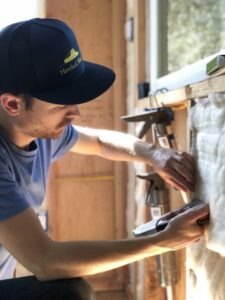We’ve been at this for 7 years. We began surrounded by building industry vets and were happy to keep our ears open and our mouths shut. We sat, we listened and we learned – in some instances more than we bargained for. In short, we’ve learned this industry is slow to evolve and like most sectors, consumers drive change; also, low and behold we are not the only ones excited about high-performance natural building materials. We also learned it is really hard to know how to make the right decisions, in fact, it’s difficult to find reliable sources for basic education.

Using Havelock experiences coupled with personal ones of team members that span continents and decades we’ve come to an unfortunate conclusion about today’s built environment: interests are misaligned.
Oversimplified: architects design, builders build, and clients pay the bill. There is a propensity to leave well enough alone but the industry has devolved to accept low-grade products as the norm and clients increasingly want more from the equation. The misalignment is easy enough to fix but not without a disruptive jolt.
Where do you go to learn more? What blog is worth reading, versus the one that is saturated with either product or author bias, or both? Is this one worth reading?
These thoughts and a handful of others have led us to a project. We intend to build something that considers what we’ve learned and the best practices of some of the bright minds we’ve been fortunate to work with over the years. We are going to document the process with video updates detailing decisions made and considerations that preceded them. We’ll include recorded commentary from industry leaders on everything from wall assembly to heating and cooling, energy source, and design. We’ll also include complete transparency on cost.
There are myths to dispel: it costs too much, it is too hard to know what to do, it is too difficult to build with high-performance materials, trusted sources are hard to find. These things just aren’t true.
We’ve built our business around transparency and helping people make informed decisions. This is merely an extension of those principles. And if we get it right we will do as we do now and have a ton of fun helping people learn how to build better.
As we get underway we will happily include a list of collaborators. We are not looking for money or sponsorship as that does no good for someone who wants to replicate the process. That said, there are loads of ways to get involved and we are happy to learn and share ideas of those who have relevant experience.
Finally, this will all take place in a dedicated space at our facility. Visitors will be welcome so long as you appropriately distance yourself and don’t share your coffee or beer with anyone.

I don’t have much to say. I’m a new van owner and am retiring in January in order to pursue my adventure. Which, incidentally… is way outside my comfort zone. I’m here to learn. I really like your company; your philosophy; and your involvement and sincere concern for this evolving segment of building material.
Dave – Thanks for the kind words and good luck on your adventure. We are glad to have you onboard.
After doing the search I came to the conclusion that your product looks really good and I’ll choose it for my Van IF I’ll do insulation.
My van is a Chevy express passenger van that has the windows all around which I’m not going to block.
My main concern is heat and not so much cold weather.
So if the heat gets in through the window glass or when you open the door an insulation actually will prevent the heat from leaving.
So why should I put one at all?
Just like your professional opinion about my thoughts.
Thank You.
Ronnie – Thanks for reaching out. Insulation will keep your van cool by reducing the conductive flow of heat through your van walls. When heat from the sun warms the outside of your van, the heat is transferred inside through conduction. When it’s cold, heat also transfers out of the van via conduction. We can slow this process of heat transfer by insulating the walls and ceiling. We also suggest window coverings to limit radiant heat. Thanks!
I’m not exactly sure what you are proposing here, but I am very interested to see where it goes. I am an electrician by trade, and have noticed some truly shoddy building practices over the years. I am looking at the possibility of general contracting my next house, and don’t feel like there is a lot of quality in the way homes are typically constructed right now. I see some of the methods from a hundred plus years ago as holding up much better than many of today’s methods seem to, but homes were not nearly as tight then, so there is this missing understanding of how to improve efficiencies without sacrificing quality, and then the whole air quality piece which is why your product really interests me. Anyway, looking forward to seeing where this goes, thank you for caring.
Retirement is really close and we are almost done with our van build. Using your product and knowing it is safe to use has been a great thing. I probably do not have much to contribute but any that asks what they should use, I always mention your product. Got to say, my dachshund loved the smell of it when we installed the wool (-:
Thank you for writing this article about insulation in the building industry. I owned a professional home remodeling business for 35 years and have to concur that insulating a home was one of the most misunderstood and debated subject in the entire industry. I agree that the industry is extremely slow, slow, slow to evolve…which I feel is a reflection on the human condition. I experienced much frustration in an industry that i truly enjoyed. I’m glad you guys are listening more and talking less…hope this example leads the way for the entire building industry.